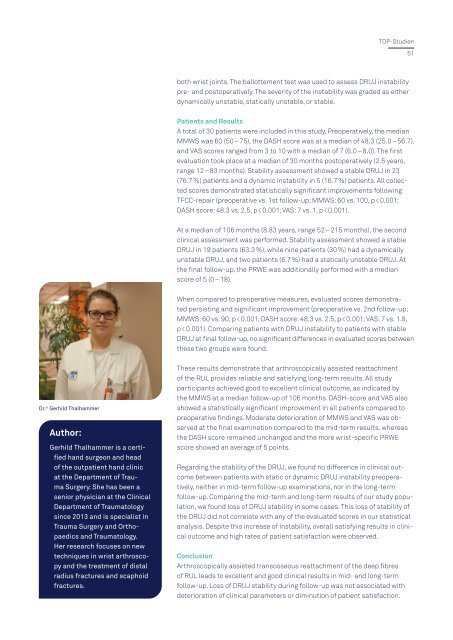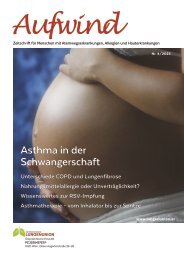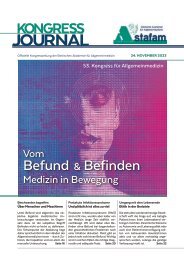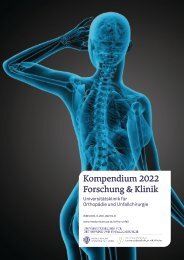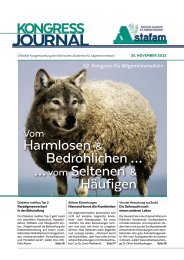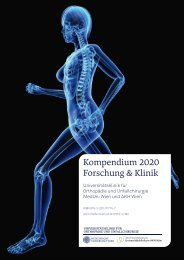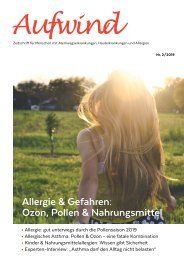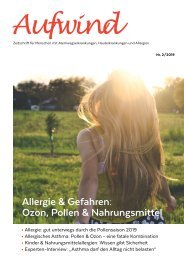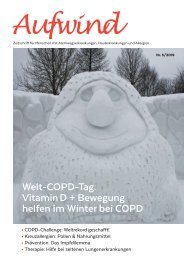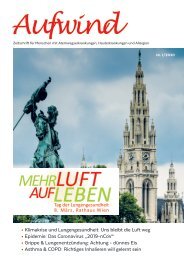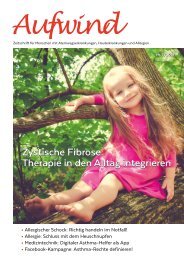Kompendium 2021 Forschung & Klinik
Universitätsklinik für Orthopädie und Unfallchirurgie MedUni Wien und AKH Wien; Leitung: o. Univ.-Prof. Dr. Reinhard Windhager www.meduniwien.ac.at/ortho-unfall www.unlimitedmedia.at/orthopaedie2021
Universitätsklinik für Orthopädie und Unfallchirurgie MedUni Wien und AKH Wien; Leitung: o. Univ.-Prof. Dr. Reinhard Windhager
www.meduniwien.ac.at/ortho-unfall
www.unlimitedmedia.at/orthopaedie2021
Erfolgreiche ePaper selbst erstellen
Machen Sie aus Ihren PDF Publikationen ein blätterbares Flipbook mit unserer einzigartigen Google optimierten e-Paper Software.
TOP-Studien<br />
51<br />
both wrist joints. The ballottement test was used to assess DRUJ instability<br />
pre- and postoperatively. The severity of the instability was graded as either<br />
dynamically unstable, statically unstable, or stable.<br />
Patients and Results<br />
A total of 30 patients were included in this study. Preoperatively, the median<br />
MMWS was 60 (50 – 75), the DASH score was at a median of 48.3 (25.0 – 56.7),<br />
and VAS scores ranged from 3 to 10 with a median of 7 (6.0 – 8.0). The first<br />
evaluation took place at a median of 30 months postoperatively (2.5 years,<br />
range 12 – 83 months). Stability assessment showed a stable DRUJ in 23<br />
(76.7 %) patients and a dynamic instability in 5 (16.7 %) patients. All collected<br />
scores demonstrated statistically significant improvements following<br />
TFCC-repair (preoperative vs. 1st follow-up; MMWS: 60 vs. 100, p < 0.001;<br />
DASH score: 48.3 vs. 2.5, p < 0.001; VAS: 7 vs. 1, p < 0.001).<br />
At a median of 106 months (8.83 years, range 52 – 215 months), the second<br />
clinical assessment was performed. Stability assessment showed a stable<br />
DRUJ in 19 patients (63.3 %), while nine patients (30 %) had a dynamically<br />
unstable DRUJ, and two patients (6.7 %) had a statically unstable DRUJ. At<br />
the final follow-up, the PRWE was additionally performed with a median<br />
score of 5 (0 – 18).<br />
When compared to preoperative measures, evaluated scores demonstrated<br />
persisting and significant improvement (preoperative vs. 2nd follow-up;<br />
MMWS: 60 vs. 90, p < 0.001; DASH score: 48.3 vs. 2.5, p < 0.001; VAS: 7 vs. 1.8,<br />
p < 0.001). Comparing patients with DRUJ instability to patients with stable<br />
DRUJ at final follow-up, no significant differences in evaluated scores between<br />
these two groups were found.<br />
Dr. in Gerhild Thalhammer<br />
Author:<br />
Gerhild Thalhammer is a certified<br />
hand surgeon and head<br />
of the outpatient hand clinic<br />
at the Department of Trauma<br />
Surgery. She has been a<br />
senior physician at the Clinical<br />
Department of Traumatology<br />
since 2013 and is specialist in<br />
Trauma Surgery and Orthopaedics<br />
and Traumatology.<br />
Her research focuses on new<br />
techniques in wrist arthroscopy<br />
and the treatment of distal<br />
radius fractures and scaphoid<br />
fractures.<br />
These results demonstrate that arthroscopically assisted reattachment<br />
of the RUL provides reliable and satisfying long-term results. All study<br />
partici pants achieved good to excellent clinical outcome, as indicated by<br />
the MMWS at a median follow-up of 106 months. DASH-score and VAS also<br />
showed a statistically significant improvement in all patients compared to<br />
preoperative findings. Moderate deterioration of MMWS and VAS was observed<br />
at the final examination compared to the mid-term results, whereas<br />
the DASH score remained unchanged and the more wrist-specific PRWE<br />
score showed an average of 5 points.<br />
Regarding the stability of the DRUJ, we found no difference in clinical outcome<br />
between patients with static or dynamic DRUJ instability preoperatively,<br />
neither in mid-term follow-up examinations, nor in the long-term<br />
follow-up. Comparing the mid-term and long-term results of our study population,<br />
we found loss of DRUJ stability in some cases. This loss of stability of<br />
the DRUJ did not correlate with any of the evaluated scores in our statistical<br />
analysis. Despite this increase of instability, overall satisfying results in clinical<br />
outcome and high rates of patient satisfaction were observed.<br />
Conclusion<br />
Arthroscopically assisted transosseous reattachment of the deep fibres<br />
of RUL leads to excellent and good clinical results in mid- and long-term<br />
follow-up. Loss of DRUJ stability during follow-up was not associated with<br />
deterioration of clinical parameters or diminution of patient satisfaction.


